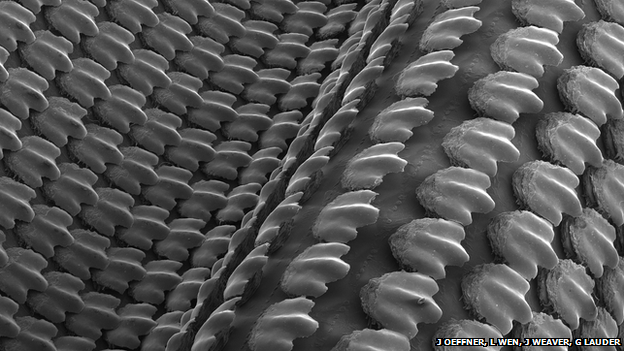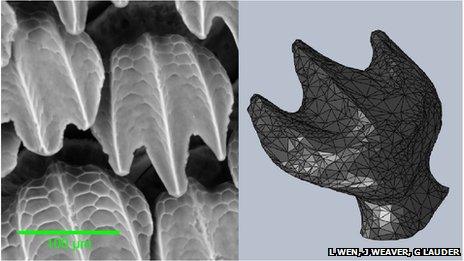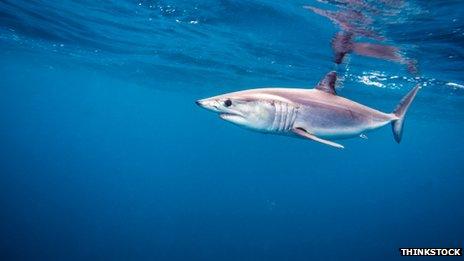3D printing reveals the power of shark skin
- Published

The printed replica included tough "denticles" embedded in a smooth, flexible membrane
Scientists have used a 3D-printed model of shark skin to show how tooth-like scales help the predators to cruise efficiently.
Viewed up close, a shark's skin bristles with tiny teeth or "denticles" which aid swimming.
Engineers have tried to mimic the roughness of shark skin when designing swim suits and even racing cars.
But the denticles have never been so well reproduced before, says a report, external in the Journal of Experimental Biology.
Perhaps counter-intuitively, creating turbulence near the edge of a moving object can reduce drag. In this way, the denticles act like the dimples on a golf ball. Now, researchers have also seen them alter specific currents that help propel the shark through water.
George Lauder and his colleagues took a detailed scan of a tiny square of skin from a mako shark, and built a 3D model of a single denticle just 0.15mm long.
The challenge was then to manufacture a synthetic skin, with thousands of these denticles embedded in a smooth, flexible membrane.
"It took us about a year," said Prof Lauder, of Harvard University.

First the team made a detailed 3D model of a single denticle
3D printing builds up new objects layer-by-layer, following a computer-generated design. To print the shark skin, the scientists had to use two different materials for the hard, tooth-like structures and for the flexible base - much like the different coloured inks used to print a picture.
The particular shape of the denticles also posed difficulties: "Because they're overhung, the 3D printers have to print a supporting material, which you then have to remove," Prof Lauder told the BBC. "It took a while to work out all the tricks."
The artificial skin has impressed Oliver Crimmen, a fish expert at the Natural History Museum who has previously advised Speedo on swim suit design.
"I used to think, how on earth would you mimic that complex structure accurately?" he said. "3D printing is it - what a marvellous application for it."
Because the resolution of even the latest 3D printers is limited, the artificial denticles are about 10 times larger than the real ones seen on the skin of a mako shark.
Nonetheless, when the team stuck the new artificial skin onto a small, flexible paddle and studied it in a water tank, they were able to see the benefit sharks glean from their unusual scales.
A paddle with the new, toothy skin delivered a boost of up to 6.6% in swimming speed, compared to one coated with the smooth membrane alone. The artificial denticles also allowed the paddle to travel the same simulated distance while using 5.9% less energy.
"That's a huge effect, when factored over the entire lifetime of an animal that is constantly swimming," said Prof Lauder.

Sharks' specialised skin appears to help most when they are cruising, rather than accelerating to catch prey
Mr Crimmen agrees. "If you think about it, sharks, which don't have a swim bladder... are on the go most of their lives. Swimming's hard work, especially if you're of any size."
Interestingly, the advantages were most obvious at relatively slow speeds, when the shark is cruising rather than pouncing. "It's during the steady, long-distance migrations that you'd really begin to see the benefits," Prof Lauder explained.
Using a specialised technique to photograph the flow of water, the team also found that the "leading edge vortex", a small whirlpool of low pressure generated by the paddle's movement, was stronger with the denticles than without.
Prof Lauder believes this change in water flow could be crucial. "It can help suck the fish forward," he said. "One of the things that our flow visualisation has suggested is that the structure of the skin may actually increase the thrust - the engine of propulsion - rather than just reducing the drag."
When attached to a paddle and studied in a water tank, the artificial skin strengthened the "leading edge vortex" created by a swimming motion. Video courtesy of L. Wen, J. Weaver, G. Lauder
Researchers have studied the fluid dynamics of moulds and real samples of shark skin before. Prof Lauder is especially pleased with this new, 3D-printed model because it moves and bends, just like sharks. "You have a rigid scale structure embedded into a flexible membrane, that can then swim."
Don't expect to be pulling on a denticle-laden swim suit any time soon, however. Transferring this type of design to a textile might take decades, Prof Lauder said. "But if you could do it, you would see a dramatic effect on swimming performance!"
The idea of copying design elements from biological systems is known as biomimetics.
3D printing technology has made such mimicry a lot easier and, importantly, it allows the designs to be tweaked. For example, Prof Lauder and his team have already begun to play with the spacing, arrangement and shape of the denticles. "I want to know what causes this effect," he said.
Aside from that curiosity, Prof Lauder enjoys learning from nature. "It pays us to understand how the natural world works," he told BBC News. "Millions of years of evolution give us solutions to problems that we may not have thought of."